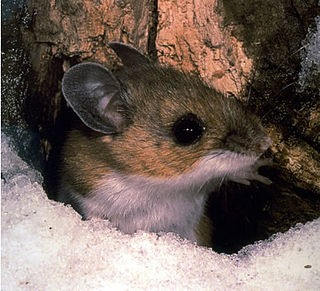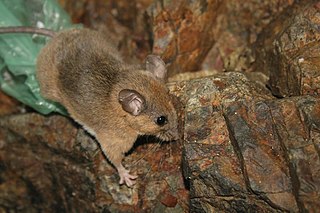
Peromyscus is a genus of rodents. They are commonly referred to as deer mice or deermice, not to be confused with the chevrotain or "mouse deer". They are New World mice only distantly related to the common house and laboratory mouse, Mus musculus. From this relative, Peromyscus species are distinguished by relatively larger eyes, and also often two-tone coloring, with darker colors over the dorsum (back), and white abdominal and limb hair-coloring. In reference to the coloring, the word Peromyscus comes from Greek words meaning "booted mouse". They are also accomplished jumpers and runners by comparison to house mice, and their common name of "deer mouse" is in reference to this agility.
Schmidly's deer mouse, is a recently described species of deer mouse from the mountains of western Mexico. It is part of the highly complex and well-studied Peromyscus boylii species complex. The uniqueness of Peromyscus from this area had long been suspected, but was only formalized in 2004 with the publication of its species description. The species was named in honor of David J. Schmidly, a mammalogist and former president of the University of New Mexico.

The Neotominae are a subfamily of the family Cricetidae. They consist of four tribes, 16 genera, and many species of New World rats and mice, predominantly found in North America. Among them are the well-known deer mice, white-footed mice, packrats, and grasshopper mice.

Sumichrast's vesper rat is a rodent of the family Cricetidae found from southern Mexico to Panama. It is named for François Sumichrast, the collector of the first specimen, and its closest relative is probably Hatt's vesper rat, a similar, but slightly smaller, species from the Yucatán Peninsula.

The Aztec mouse is a species of rodent in the family Cricetidae, native to southern Mexico and parts of Central America.

The Perote mouse, or Perote deer mouse, is a species of rodent in the family Cricetidae. It is found only in Mexico.

The Zacatecan deer mouse or southern rock mouse is a species of rodent in the family Cricetidae. It is found only in Mexico, and is not considered endangered.
The blackish deer mouse is a species of rodent in the family Cricetidae found only in Mexico, and is relatively poorly studied.
The Angel Island mouse, or La Guarda deermouse, is a species of rodent in the family Cricetidae.
Hooper's mouse is a species of rodent in the family Cricetidae. It is the only member of the Peromyscus hooperi species group, and is found only in Mexico. The species is named for Emmett Hooper, a researcher into the taxonomy of the genus Peromyscus.
The nimble-footed mouse is a species of rodent in the family Cricetidae. It is found only in Mexico.

The Tres Marías island mouse or Tres Marías deer mouse is a species of rodent in the family Cricetidae. It is found only on the Islas Marías off the west coast of Mexico. When last assessed, it was common on María Cleofás Island, but rare or absent on the other, more disturbed, islands.

The black-eared mouse, or black-eared deer mouse, is a species of rodent in the family Cricetidae, native to North America.

The Mexican deer mouse is a species of forest-dwelling rodent in the family Cricetidae. It is found in southern Mexico and throughout much of Central America.

The Nayarit mouse or Sinaloan deer mouse is a species of cricetid rodent endemic to Mexico. It was considered a subspecies of brush mouse until 1977.
Winkelmann's mouse is a species of rodent in the family Cricetidae found only in Mexico, and is named for John R. Winkelmann, who collected the first specimens.

The Magdalena rat is a species of rodent in the family Cricetidae which is found only in a small region of western Mexico.

The grayish or gray mouse opossum is a diminutive species of opossum in the family Didelphidae, endemic to Mexico. It is the sole species of its monotypic genus, Tlacuatzin.

Kilpatrick's deer mouse is a small species of rodent in the family Cricetidae, native to mountainous regions of Michoacán, Mexico. It is found in the Trans-Mexican Volcanic Belt pine–oak forests in mesic forest habitats dominated by pine and oak at elevations above 1,600 meters. The species can be found in micro-habitats associated with rocky outcrops and fallen trees. The species is named after Dr. C. William Kilpatrick, curator of vertebrates at the University of Vermont Natural History Museum. The holotype of this species is part of the Natural Science Research Laboratory collections at the Museum of Texas Tech University.













